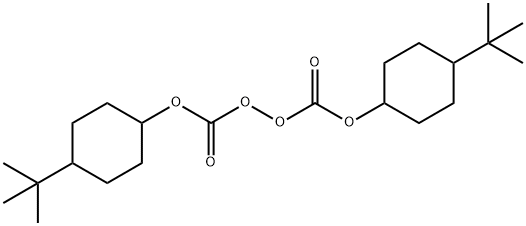|
|
| | Bis(4-tert-butylcyclohexyl) peroxydicarbonate Basic information |
| Product Name: | Bis(4-tert-butylcyclohexyl) peroxydicarbonate | | Synonyms: | Bis(5-tert-butylcyclohexyl) peroxydicarbonate;1-tert-butyl-1-[(1-tert-butylcyclohexyl)-methyldioxymethyl]cyclohexane;4-TERT-BUTYLCYCLOHEXYL {[(4-TERT-BUTYLCYCLOHEXYL)OXY]CARBONYL}OXY CARBONATE;Di-(4-tert.-butylcyclohexyl)-peroxydicarbonat;Bis(4-tert-butylcyclohexyl) peroxydicarbonate;Di-(4-tert-butylcyclohexyl)peroxydicarbonate;Perkadox 16;Perkadox | | CAS: | 15520-11-3 | | MF: | C22H38O6 | | MW: | 398.53 | | EINECS: | 239-557-1 | | Product Categories: | | | Mol File: | 15520-11-3.mol |  |
| | Bis(4-tert-butylcyclohexyl) peroxydicarbonate Chemical Properties |
| Melting point | 91-92°C | | Boiling point | 435.1±28.0 °C(Predicted) | | density | 1.06±0.1 g/cm3(Predicted) | | vapor pressure | 0.01Pa at 20℃ | | storage temp. | 2-8°C | | solubility | Chloroform (Slightly), Methanol (Slightly) | | form | Solid | | color | White to Off-White | | Water Solubility | 600ng/L at 20℃ | | Stability: | Light Sensitive | | InChI | InChI=1S/C22H38O6/c1-21(2,3)15-7-11-17(12-8-15)25-19(23)27-28-20(24)26-18-13-9-16(10-14-18)22(4,5)6/h15-18H,7-14H2,1-6H3 | | InChIKey | NOBYOEQUFMGXBP-UHFFFAOYSA-N | | SMILES | C(OC1CCC(C(C)(C)C)CC1)(=O)OOC(OC1CCC(C(C)(C)C)CC1)=O | | LogP | 8.34 | | EPA Substance Registry System | Peroxydicarbonic acid, C,C'-bis[4-(1,1-dimethylethyl)cyclohexyl] ester (15520-11-3) |
| Hazard Codes | O | | Risk Statements | 7 | | Safety Statements | 3-7-14-36/37/39-17 | | RIDADR | UN 3114 5.2 | | WGK Germany | 1 | | HS Code | 29209090 |
| | Bis(4-tert-butylcyclohexyl) peroxydicarbonate Usage And Synthesis |
| Chemical Properties | Colorless solid | | Chemical Properties | Bis(4-tert-butylcyclohexyl) peroxydicarbonate is crystalline
solid (white powder) with slight odor, sensitive to heat
and contamination, and may decompose violently or
explosively at temperature 0–10°C, owing to self-accelerating
exothermic decomposition due to shock, heat, or
friction. To lessen the explosion risk, di-(4-tert-butylcyclohexyl)
peroxydicarbonate should be stored in a temperature
controlled vessel and mixed with water to form a
slurry of the peroxide. Hazardous polymerization does
not occur (12c). Detached storage is preferred for this
chemical, including out of direct sunlight in a cool wellventilated
place. It should be stored away from combustibles
and other incompatible materials, including strong
acids, bases, oxidizers, reducing agents, amines, and promoters/
accelerators, which may result in a violent decomposition
or explosion. Refer to the Code for the Storage of
Organic Peroxide Formulations (13a). | | Uses | Bis(4-(tert-butyl)cyclohexyl) Peroxydicarbonate is a useful raw material used in the preparation of polymerizable yellow azo dyes applied in artificial intraocular lens. A catalyst. | | Uses | Di-(4-tert-butylcyclohexyl) peroxy dicarbonate is used as
polymerization initiator. No information was located for this
compound. | | General Description | Crystalline solid. Bis(4-tert-butylcyclohexyl) peroxydicarbonate is particularly heat and contamination sensitive. These materials above a given "control temperature" may decompose violently. They are often stored in a temperature controlled vessel, also mixed with water to form a slurry of the peroxide. This greatly lessens the explosion hazard risk. | | Reactivity Profile | DI-(4-TERT-BUTYLCYCLOHEXYL)PEROXYDICARBONATE decomposes violently or explosively at temperatures 0-10° C. owing to self-accelerating exothermic decomposition; Several explosions were due to shock, heat or friction; amines and certain metals can cause accelerated decomposition [Bretherick, 1979 p. 156]. |
| | Bis(4-tert-butylcyclohexyl) peroxydicarbonate Preparation Products And Raw materials |
|